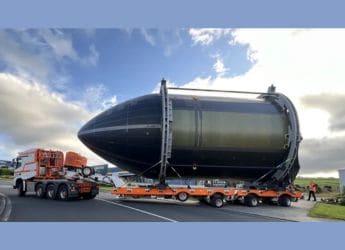- Home
- Science
- Science News
- Pilot Actions Being Examined in Virgin Galactic Spacecraft Crash
Pilot Actions Being Examined in Virgin Galactic Spacecraft Crash

The untimely engagement of the tail mechanism, designed to slow the vehicle's descent into the atmosphere from space, and the possibility that pilot error was to blame, were disclosed by the National Transportation Safety Board (NTSB) late on Sunday and have emerged as a main thrust of the inquiry into Friday's crash.
"We know already from having the lever move from lock to unlock that we need to get a human-factors person in here," said NTSB Chairman Christopher Hart. "The question then is why did that happen when it happened?"
Investigators have yet to determine whether releasing the tail mechanism too early caused or contributed to the crash of the space plane near the Mojave Air and Space Port, about 95 miles (150 km) north of Los Angeles, Hart said in an interview.
The suborbital rocket vehicle dubbed SpaceShipTwo broke into pieces over California's Mojave Desert and crashed shortly after its separation from the special jet aircraft that carries it aloft for its high-altitude launches.
The crash, which unfolded without SpaceShipTwo catching fire or exploding in flames, came on its fourth powered test flight, the first since January.
Video footage from the cockpit shows co-pilot Michael Alsbury, 39, who died in the crash, releasing a lever to unlock the twin-tail section eight seconds after SpaceShipTwo's engine ignited, Hart told reporters on Monday night.
Two seconds later the tail, which did not have sufficient aerodynamic pressure to hold it in place, began to pivot upward, a maneuver designed to increase drag for atmospheric re-entry.
Mystery of pilot's survival
Investigators also are trying to determine how surviving pilot Pete Siebold, 43, managed to get out of the rocket plane and parachute to the ground from a height of roughly 50,000 feet, an altitude virtually devoid of oxygen.
Hart said Siebold, now hospitalized with a shoulder injury, did not exit through the cockpit's escape hatch. "We know it wasn't through there, so how did this pilot get out?" he said.
SpaceShipTwo, developed by the fledgling space tourism company of billionaire entrepreneur Richard Branson, was designed to carry wealthy passengers on short rides into space, with Virgin Galactic planning to begin offering its first flights to paying customers next spring.
The crash came three days after the unmanned rocket of another private space company, Orbital Sciences Corp, exploded during liftoff from a commercial launch pad in Virginia on a mission, under contract with Nasa, to deliver cargo to the International Space Station.
Hart told a news conference on Sunday that investigators had determined SpaceShipTwo's tail system was supposed to have been released for deployment as the craft was traveling about 1.4 times the speed of sound. Instead, the tail section began pivoting when the vehicle was flying at Mach 1, the speed of sound.
"I'm not stating that this is the cause of the mishap. We have months and months of investigation to determine what the cause was," Hart said.
Asked if pilot error was a possible factor, Hart said: "We are looking at all of these issues to determine what was the root cause of this mishap ... including that possibility."
Also unclear was exactly how the tail mechanism began to rotate once it was unlocked, since that maneuver requires a separate pilot command that was never given, Hart said.
This raised questions about whether the craft's position in the air and its speed somehow enabled the tail section to swing free on its own.
About 800 people have paid or put down deposits for a ride into space at $250,000 a seat. Branson plans to be on the first commercial flight with his son.
Branson said Monday his company's venture was "absolutely" worth the risks. "It's a grand program, which has had a horrible setback, but I don't think anybody ... would want us to abandon it at this stage," he told NBC.
© Thomson Reuters 2014
Get your daily dose of tech news, reviews, and insights, in under 80 characters on Gadgets 360 Turbo. Connect with fellow tech lovers on our Forum. Follow us on X, Facebook, WhatsApp, Threads and Google News for instant updates. Catch all the action on our YouTube channel.
Related Stories
- Samsung Galaxy Unpacked 2025
- ChatGPT
- Redmi Note 14 Pro+
- iPhone 16
- Apple Vision Pro
- Oneplus 12
- OnePlus Nord CE 3 Lite 5G
- iPhone 13
- Xiaomi 14 Pro
- Oppo Find N3
- Tecno Spark Go (2023)
- Realme V30
- Best Phones Under 25000
- Samsung Galaxy S24 Series
- Cryptocurrency
- iQoo 12
- Samsung Galaxy S24 Ultra
- Giottus
- Samsung Galaxy Z Flip 5
- Apple 'Scary Fast'
- Housefull 5
- GoPro Hero 12 Black Review
- Invincible Season 2
- JioGlass
- HD Ready TV
- Laptop Under 50000
- Smartwatch Under 10000
- Latest Mobile Phones
- Compare Phones
- Redmi Note 15 5G
- Redmi Note 15 Pro 5G
- Redmi Note 15 Pro+ 5G
- Lava Play Max
- Poco C85 5G
- Honor Magic 8 Lite
- Jolla Phone
- Realme P4x 5G
- Asus ProArt P16
- MacBook Pro 14-inch (M5, 2025)
- OnePlus Pad Go 2
- Poco Pad M1
- Just Corseca Skywatch Pro
- Honor Watch X5
- Acerpure Nitro Z Series 100-inch QLED TV
- Samsung 43 Inch LED Ultra HD (4K) Smart TV (UA43UE81AFULXL)
- Asus ROG Ally
- Nintendo Switch Lite
- Haier 1.6 Ton 5 Star Inverter Split AC (HSU19G-MZAID5BN-INV)
- Haier 1.6 Ton 5 Star Inverter Split AC (HSU19G-MZAIM5BN-INV)

















